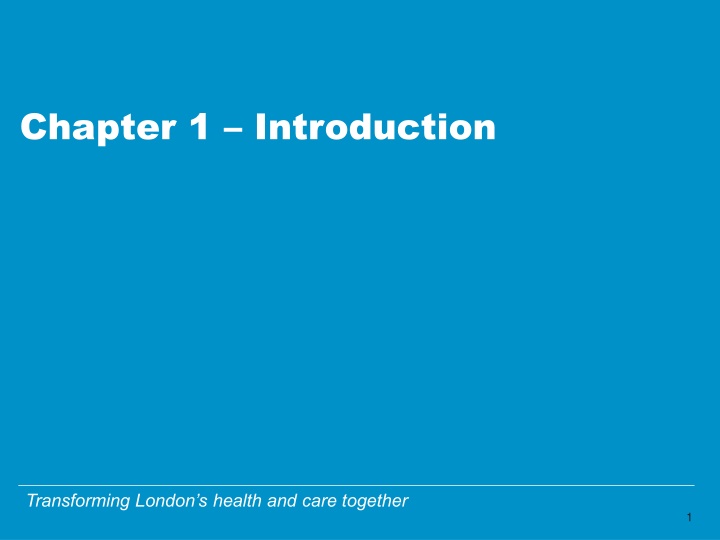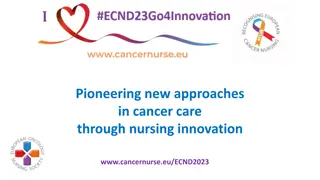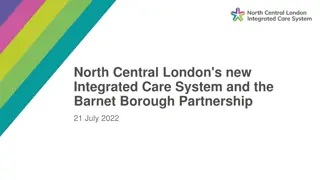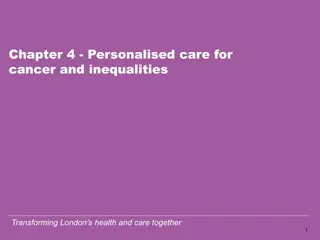Transforming Cancer Care in London and West Essex
Half of people born since 1960 in London and West Essex will be diagnosed with cancer in their lifetime, highlighting the pressing need to address cancer care inequalities. The Transforming Cancer Services Team has developed a comprehensive strategy to reduce these disparities and improve outcomes through early detection, faster diagnosis, and personalized care. The strategy aims to enhance engagement, data quality, and legal compliance in the short term, while focusing on reducing inequalities in incidence, survival, treatment, and patient experience in the long run.
Download Presentation

Please find below an Image/Link to download the presentation.
The content on the website is provided AS IS for your information and personal use only. It may not be sold, licensed, or shared on other websites without obtaining consent from the author.If you encounter any issues during the download, it is possible that the publisher has removed the file from their server.
You are allowed to download the files provided on this website for personal or commercial use, subject to the condition that they are used lawfully. All files are the property of their respective owners.
The content on the website is provided AS IS for your information and personal use only. It may not be sold, licensed, or shared on other websites without obtaining consent from the author.
E N D
Presentation Transcript
Chapter 1 Introduction Transforming London s health and care together 1
Background Issues in London and West Essex: Half of people born since 1960 will be diagnosed with cancer in their lifetime with that proportion continuing to rise. Cancer is the biggest cause of death from illness or disease in every age group, from the very youngest children through to old age. There are groups of patients for whom outcomes and quality of life are particularly poor. Whilst survival has improved significantly in some types of cancer for others it has remained stubbornly low e.g. lung. Inequalities in health mean poorer health, reduced quality of life and early death for many people. These inequalities are reflected in cancer outcomes. Certain population groups have higher incidence, poorer survival and poorer experience of care. Reducing these inequalities is challenging because they are often deep-rooted with multiple causes. Everyone should have the same opportunities to lead a healthy life, no matter where they live or who they are. Health inequalities mean there is potentially avoidable variation in survival outcomes. 2
Developing a strategy to reduce inequalities in cancer care and outcomes in London and West Essex The Transforming Cancer Services Team has produced a strategy to reduce inequalities in cancer care and outcomes in London and West Essex. The strategy underpins delivery of the three agreed London Cancer Priorities 2019/20: Early detection of cancers including through screening and education activities; Delivery of the Faster Diagnosis Standard; Access to personalised care The strategy covers clinical, psycho-social and patient experience dimensions and provides recommendations for all organisations that plan, commission and deliver cancer care for Londoners. The strategy and recommendations are based on a comprehensive needs and assets assessment which includes analysis of published data, evidence of effective interventions (including relevant NICE guidance), consultation with a range of stakeholders, the views of people affected by cancer and insights drawn from these sources. 3
Developing a strategy to reduce inequalities in cancer care and outcomes in London and West Essex The strategy will contribute towards the following short term objectives: improved engagement and integration of health and social care in relation to reducing cancer inequalities; improved data quality on cancer inequalities; support for organisations to meet the legal requirements of Health Inequalities and the Equality Act 2010. The strategy will contribute towards the following long term objectives: reduction in inequalities between population groups in cancer outcomes (incidence, prevalence, survival, mortality, experience); reduction in inequalities between population groups in key performance indicators for earlier diagnosis, treatment and personalised care for cancer (e.g. cancer waiting times, stage at diagnosis, screening coverage, recovery package and quality of life metrics) reduction in inequalities in reported patient experience; where recommended, positive discrimination. 4
London and West Essex Cancer Inequalities Strategy Outline Summary The London and West Essex Cancer Inequalities Strategy is divided into five chapters: Chapter 1 Chapter 2 Chapter 3 Chapter 4 Chapter 5 Introduction Early diagnosis and inequalities Inequalities in access and treatment for cancer Inequalities in personalised care for cancer Summary of recommendations An Inequalities Snapshot has also been developed for each STP (Appendices). 5
Index Chapter 1 - Introduction NHS Long Term Plan milestones for cancer Methods Describing inequalities in London Detailed work on marginalised groups Needs Inequalities across the pathway Evidence review of what works Recommendations for each marginalised group Professionals views Patient views Professional and patient views recommendations List of abbreviations Chapter 2 - Early diagnosis and inequalities Screening and cancer inequalities Stage 1 and 2 diagnoses across London Evidence review of what works in early diagnosis internationally and nationally Variation in 1 year survival across London Recommendations for reducing inequalities in early diagnosis 6
Index Chapter 4 inequalities in personalised care for cancer Overview of personalised care Chapter 3 Inequalities in access and treatment for cancer Cancer diagnosed as an emergency in London Inequalities reflected in patients views (NCPES) Variation in types of treatment (breast cancer) Pathway issues stratified care, health needs assessments and care plans Variation in bowel cancer outcomes Variation in lung cancer outcomes Debt and cancer 5 year survival by CCG Variation in access to psycho- oncology support Treatment modalities variation Variation in access to lymphoedema services Variation in access to trial treatment Quality of life metrics Chapter 5 summary of recommendations 7
The NHS Long Term Plan The NHS Long Term Plan Milestones for Cancer Milestones for Cancer From 2019 we will start to roll out new Rapid Diagnostic Centres across the country. In 2020 a new faster diagnosis standard for cancer will begin to be introduced so that patients receive a definitive diagnosis or ruling out of cancer within 28 days. By 2020 HPV primary screening for cervical cancer will be in place across England. By 2021, where appropriate every person diagnosed with cancer will have access to personalised care, including needs assessment, a care plan and health and wellbeing information and support. By 2022 the lung health check model will be extended. By 2023, stratified, follow-up pathways for people who are worried their cancer may have recurred. These will be in place for all clinically appropriate cancers. By 2028, the NHS will diagnose 75% of cancers at stage 1 or 2.
London vision statements HPV vaccs High quality cancer treatment children Stop smoking, alcohol support, weight management, cancer screening Personalised care for cancer, stratified follow up High quality cancer care adults Personalised care for cancer, stratified follow up ***DRAFT***
Mayors Health Inequalities Strategy Healthy children, Healthy minds, Healthy places, Healthy communities, Healthy lives Homelessness, hospital stays and discharge GLA working with the homeless health board to support this priority Social prescribing GLA role to support the voluntary sector to implement this A Hep C blueprint for eradication in London will help reduce liver cancer Immigration status GLA communities and social policy team & Doctors of the world working together 10
Methods Data sources Use of routine data sources for all analysis including Cancer data Public Health England Fingertips data National Cancer Patient Experience Survey (NCPES) Office for National Statistics (ONS) NCRAS Patient views Sought from Patient Advisory Group (London) members (PAG) Additional extended 1-1 interviews with small number of patients Professionals views Semi-structured interviews conducted with cancer STPs, alliances, specialist GPs, academics, voluntary sector, cancer charities, experts in marginalised groups (38 persons) thematic analysis 11
Describing cancer inequalities Transforming London s health and care together 12
Incidence of difference cancers and deprivation Source PHE fingertips For breast cancer, incidence increases with decreasing deprivation (richer) of London CCGs using IMD 2015 and cancer incidence data from 2014-16 For other cancers such as colorectal cancer there is no clear relationship between deprivation and incidence For stomach and lung cancer, incidence increases with increasing deprivation i.e. there is more cancer in poorer populations From https://fingertips.phe.org.uk/search/deprivation#page/3/gid/1/pat /46/par/E39000018/ati/165/are/E38000004/iid/91872/age/1/sex/ 4. 13
Incidence of breast cancer and deprivation Breast cancer as CCG deprivation increases, incidence goes down. Source: IMD 2015 CCG Age-standardised incidence rate of breast (C50) tumours by deprivation score 200 180 160 Age-sandardised incidence rate (per 100,000) 140 120 100 80 60 40 20 0 0 5 10 15 20 25 30 35 40 Deprivation Score (IMD 2015) 14
Incidence of stomach cancer and deprivation As deprivation increases for CCGs (poorer), so too does incidence of stomach cancer CCG Age-standardised incidence of stomach (C16) tumours by deprivation score 20 18 Age standardised Incdence Rate (per 100,000) 16 14 12 10 8 6 4 2 0 0.0 5.0 10.0 15.0 20.0 25.0 30.0 35.0 40.0 Deprivation Score (IMD 2015) 15
Incidence of lung cancer and deprivation As deprivation increases for CCGs (poorer), incidence increases CCG Age-standardised incidence of lung (C33-C34) tumours by deprivation score 120 100 Age standardised Incdence Rate (per 100,000) 80 60 40 20 0 0.0 5.0 10.0 15.0 20.0 25.0 30.0 35.0 40.0 Deprivation Score (IMD 2015) 16
Cancer Incidence and Ethnicity Across London (2015) Cancer Incidence and Ethnicity Across London (2015) In 2018 the TCST-NCRAS partnership published age-standardised cancer incidence rates by ethnicity at STP level throughout London for 25 tumour groups. This is the first time this data has been made available and supports findings at National level for England. Asian, Chinese and Mixed men and women and Black women are significantly less likely or similarly likely to be diagnosed with any cancer compared with the White population, but Black men are significantly more likely. Ethnic Group Asian Black Chinese Mixed 1.1 1.8 1.3 1.4 1.3 1.4 1.6 1.4 Times more or less likely to be diagnosed with cancer relative to White men and women Figure 1: The likelihood of non-White ethnic groups receiving any cancer diagnosis relative to White population in London, 2015 These findings are driven by the incidence of specific tumour groups Wickramasinghe B, 2018
Ethnic Group Asian Black Chinese Mixed Tumour Group ICD-10 Code Men Women Men Women Men Women Men Women Total cancers C00-C97 except C44 Ethnic Group Asian Black Chinese Mixed Tumour Group ICD-10 Code All C00-C97 except C44 tumours not included in the following C00-C97 except C44 Men Women Men Women Men Women Men Women Other Total cancers Ethnic Group Asian Black Chinese Mixed Tumour Group ICD-10 Code All C00-C97 except C44 tumours not included in the following C00-C97 except C44 Bladder Other Total cancers C67 Men Women Men Women Men Women Men Women Melanoma C43 Oesophagus C15 Unknown Bladder Other C77-C80 C67 Cancer Incidence and Ethnicity Across London (2015) Cancer Incidence and Ethnicity Across London (2015) All C00-C97 except C44 tumours not included in the Brain C70-C72 C43 following Melanoma Lung C33-C34 C15 Oesophagus Mesothelial & Soft tissue Unknown Bladder C45-C49 C77-C80 C67 Ethnic Group Black For most cancers, Asian, Black, Chinese and Mixed ethnic Non hodgkin lymphoma Brain Melanoma C82-C85 C70-C72 C43 Asian Chinese Mixed Cancer Group Head&Neck Lung Oesophagus C00-CC10, C12-C14, C30-C32 C33-C34 C15 Men Women Men Women Men Women Men Women rank Colorectal C18-C20 C45-C49 C77-C80 Mesothelial & Soft tissue Unknown # groups are significantly less likely Total Invasive Cancers exc. NMSC Kidney renal pelvis and ureter Non hodgkin lymphoma Brain or similarly likely to be diagnosed compared with the White population; but have an increased likelihood for certain cancers. C64-CC66, C68 C82-C85 C70-C72 Hodgkin lymphoma Head&Neck Lung C81 C00-CC10, C12-C14, C30-C32 C33-C34 Pancreas Colorectal C25 Female Specific Cancers Female Breast C18-C20 C45-C49 - - - - 5 Leukaemia C91-C95 C64-CC66, C68 C82-C85 Mesothelial & Soft tissue Kidney renal pelvis and ureter Non hodgkin lymphoma Ovary Cervix Uterus - - - - 5 Liver C22 C81 Hodgkin lymphoma Head&Neck - - - - 6 Multiple Myeloma Pancreas Colorectal C90 C25 C18-C20 C00-CC10, C12-C14, C30-C32 - - - - 9 Stomach Leukaemia C16 C91-C95 C64-CC66, C68 Thyroid & Endocrine Liver Hodgkin lymphoma C73-C75 C22 C81 Kidney renal pelvis and ureter Male Specific Cancers Testis Prostate - - - - 5 Female Specific Tumour Groups Female Breast Stomach Leukaemia This includes prostate cancer in Black men, which was observed to be the main driver of findings for all cancers combined Multiple Myeloma Pancreas C90 C25 C50 C16 C91-C95 - - - - - - - - 7 Ovary C56 - - - - Thyroid & Endocrine C73-C75 Bladder Melanoma Oesophagus Brain Lung Cervix Liver C53 C22 8 - - - - Female Specific Tumour Groups Female Breast Stomach Uterus C54-C55 C50 C16 8 - - - - - - - - Multiple Myeloma C90 9 Male Specific Tumour Groups Testis Cervix Female Specific Tumour Groups Female Breast Ovary C56 - - - - # Thyroid & Endocrine C73-C75 C62 C53 - - - - - - - - # Prostate Uterus C61 - - - - C54-C55 C50 Key Areduced likelihood of developing cancer compared to Testis Cervix - - - - Mesothelial & Soft tissue Non-Hodgkin lymphoma Head&Neck Colorectal Kidney, renal pelvis and ureter Hodgkin lymphoma Pancreas Leukaemia Liver Multiple Myeloma Stomach Thyroid & Endocrine Unknown Other # - - - - # Male Specific Tumour Groups Ovary C56 - - - - = a reduced likelihood of developing cancer compared to the White population = the same likelihood of developing cancer compared to the White population = an increased likelihood of developing cancer compared to the White population White men/women Prostate Uterus C54-C55 C62 C53 - - - - # - - - - C61 - - - - # - - - - # The same likelihood of developing cancer compared to White men/women Male Specific Tumour Groups Testis # = a reduced likelihood of developing cancer compared to the White population = the same likelihood of developing cancer compared to the White population = an increased likelihood of developing cancer compared to the White population Prostate C62 - - - - # C61 - - - - # # An increased likelihood of developing cancer compared to White men/women = a reduced likelihood of developing cancer compared to the White population = the same likelihood of developing cancer compared to the White population = an increased likelihood of developing cancer compared to the White population # # # 9 Figure 2: The likelihood of non-White ethnic groups receiving specific cancer diagnoses relative to White population in London, 2015 = a reduced likelihood of developing cancer compared to the White population = the same likelihood of developing cancer compared to the White population = an increased likelihood of developing cancer compared to the White population Wickramasinghe B, 2018 18
Inequalities in cancer prevention: HPV vaccination Not all CI overlap, highest City and lowest H&F Note that all 8 NWL CCGs are red Too early to find relationship between HPV and cervical cancer incidence as first cohort from 2009 only just turning 23yo Messages to parents to reassure new policy should include all boys Please note that England s mortality from throat and anal cancer (related to HPV infection) is increasing (ONS up to 2017) 19
Marginalised groups and cancer Transforming London s health and care together 20
Drug and alcohol users What are the cancer issues? Alcohol use alcohol most strongly increased the risks for cancers of the oral cavity, pharynx, esophagus, and larynx. Statistically significant increases in risk also existed for cancers of the stomach, colon, rectum, liver, female breast, and ovaries. risk may be increased additionally due to concurrent smoking with alcohol. (Bagnardi et al meta analysis) Drug use Intra-venous drug use - IVDU - greater risk of blood borne viruses (BBVs) such as Hep B and C therefore raised risk of primary liver cancer Khat increased risk of oral cancers (especially when concomitant alcohol and smoking) Cannabis increased risk of cancers of e.g. lung, head and neck, and a type of testicular cancer (non seminomatous germ cell tumour) Crystal methamphetamine (carcinogens in chemicals used to create it e.g. benzene) 21
Drugs and alcohol Case study Physical health checks in substance misuse patients CNWL have absorbed two stop smoking workers and ensure all clients are offered stop smoking. Central North West London (CNWL) and The Hillingdon Hospital: Alcohol psychological support team in a hospital Nurses in addiction do detailed checks of clients physical health, and complete a letter for GPs with instructions on what tests are needed for the annual checks There s an in-hospital alcohol support team as a partnership between The Hillingdon Hospital and CNWL: 166 patients offered the specialist psychological help. Found a 44% reduction in mean alcohol consumption in people accepting the intervention. Hand held spirometry for lung function offered to all Liver health Routine liver ultrasound (USS) for all patients (currently done by co-located Gastroenterology teams in Ealing and Hillingdon Hospitals) Reduced alcohol use = reduced risk of oral/GI/Liver cancers Joined up BBV pathway so Hep C + patients have access to treatment, reducing likelihood of cirrhosis and liver cancer The cost impact of outreach testing and treatment for hepatitis C in an urban Drug Treatment Unit (Selvapatt et al) Parker et al poster - Evaluation of a hospital-based alcohol support team. 22
Drugs and alcohol What needs to change in London? Recommendations All acute trusts to have an alcohol support team/ward based alcohol advice with link in to community services All addiction services to review the physical health of their clients and ensure GPs have detailed guidance for the annual physical health check. Encourage cancer screening via the nurse letter to GPs joined up care All addiction clients to be offered stop smoking to prevent oral and lung cancer Provide joined up Gastroenterology/addiction services to prevent detect, and treat cancers related to alcohol or intravenous drug use. Roll out liver USS for all substance misuse patients to pick up early liver disease Links to NHS Long Term Plan Alcohol support in hospital features in the NHS LTP Stop smoking services in hospital also feature in LTP Can we learn from other techniques in addiction services? having particular services close to where people live (supervised consumption and needle exchange) using financial incentives to encourage people to come to psychological services 23
Severe mental illness (SMI) and cancer What are the cancer issues? Difficulty coping with cancer treatment (Howard et al, 2010) https://www.thelancet.com/journals/l anonc/article/PIIS1470- 2045(10)70085-1/fulltext Higher risk of cancer with SMI People with SMI (most commonly schizophrenia and bipolar disorder) at greater risk of poor physical health (NHS LTP 2019) Higher obesity, high levels dual diagnosis (self medicating with alcohol/drugs 75% of SMI), smoking (50% in inpatients) Poorer outcomes for cancer if people are a user of psychiatric services before their diagnosis reasons could be biological/stress mechanisms, or that patients received sub standard care (Klaassen et al 2019) People in contact with mental health services 30% more likely to die from cancer than rest of population (Clifton et al) https://www.ncbi.nlm.nih.gov/pubmed/27405348 Lower screening coverage Woodhead et al 2016 lower odds ratio for attending women s breast and cervical screening, especially related to schizophrenia, depot medication and severity of illness OR 0.45-0.59 https://www.ncbi.nlm.nih.gov/pubmed/27769213 Worse cancer outcomes in breast cancer for women with bipolar disorder or depression (Kanani et al 2016) 24
Annual physical health checks for people with SMI Focus on cardiovascular disease (CVD) and risk factors like smoking/alcohol, but no mention of cancer in the checks Annual physical health checks in primary care for people with SMI in London: one year of data up to Q3 of 2018-19 60% 50% 40% 30% 20% 10% 0% Best in Hounslow, worst in Croydon 25
Mental health services Case studies from South London and the Maudsley (SLAM) Respiratory team specialist in reach Excellent focus on physical health King s in reach respiratory specialist expertise for MH patients, 81% of whom smoke Public Health strategy which includes cancer SLAM has a public health strategy with four clear areas of focus: one of which is cancer, which is explicitly included. The work to improve physical health around cancer has a clear basis: 12% of SLAM patients died of cancer, and of those people, 21% died of cancer of the digestive organs (highest proportion). For cancer the ways SLAM will prevent it, and ensure good care are as follows: focus on alcohol, blood borne virus (BBV) and vaccinations for Hepatitis B, screening. Importantly, they commit to having in house cancer screening for people who can t get out to primary care for their screens e.g. cervical screening Ref https://www.kingshealthpartners.org/our-work/mind-and-body/our- projects/physical-healthcare-in-severe-mental-illness and below 26
Mental health What needs to change in London? Recommendations (In line with SLAM) Links to NHS Long term plan: The refreshed health check referred to in the LTP has several components the checks relevant for cancer are: weight, smoking, alcohol Provide alcohol support for MH clients (dual diagnosis is very common) Ensure MH clients have their Hep B vaccinations, and harm minimisation support Currently London s 2018-19 performance is 29% having their annual heath check (good opportunity for physical health checks): more focussed on CVD. From 19-20 will be health checks in acute and MH trusts as well as in primary care for MH patients with SMI. Great variation between CCGs. Include cancer screening on the annual physical health checks for MH whether in primary or secondary care By 2020-21, NHS will ensure increase in MH clients having their physical health needs met by having yearly health checks 27
Learning disability (LD) What are the cancer issues ? People with LD have poorer access to healthcare (NHS LTP 2019) difficulty communicating physical health needs. Annual health check requirement came in from 2006 but there is poor coverage nationally. BREAST screening for eligible female patients has decreased across all age groups in both patients with and without a learning disability. However, females aged 65 to 69 with a learning disability saw the largest decrease, from 54.6% from 1 April 2014 to 31 March 2015 down to 52.3% from 1 April 2015 to 31 March 2016. Poor coding: it is likely that 30% of LD not coded as such therefore underreporting and not invited for screening. Even if 75% attend who are invited, this is only 75% of those coded as LD. Annual LD health check - 140 remuneration but not QOF so no quality / performance incentive does not reflect the work involved (many pages to fill in very lengthy exercise devised by the RCGP - could it be simplified?) Lots of barriers in secondary care lack simple and reasonable adjustments People in residential homes are even more isolated and often travel to their screen with a HCA who doesn't know them and doesn't know what their normal state is - so little understanding. 28
Learning disabilities mortality review (LeDeR) Randle & Tunmore 2019 Issues at all stages of cancer prevention, screening, treatment and palliative care. Out of 826 deaths examined, 105 were due to cancer. Of the 105 cancer deaths, 38 were either colorectal or upper GI; Key issues Difficulty with the annual checks, missing opportunities to pick up risk factors or cancer Diagnostic overshadowing not recognising cancer flags like weight loss and difficulty swallowing (dysphagia) attributing everything to the LD Lack of flexibility with screening i.e. finding practical ways to administer screening for people with different needs/abilities (e.g. stool collection aids) Referrals could add a reasonable adjustments section to 2WW forms so that hospitals prepared when investigations planned Passivity in terms of failed investigations e.g. when can t complete bowel preparations, no use of alternatives Not keeping relatives or carers up to date with patients care, resulting in poorer outcomes 29
Learning disability national good practice Northern Cancer Alliance bowel screening in inpatient MH settings http://www.northerncanceralliance.nhs.uk/wp- content/uploads/2019/04/Learning-Disability-and-Cancer- Project-Report-2017-19.pdf Project in NE and Cumbria has increased uptake of bowel screening by 30% https://www.england.nhs.uk/cancer/case- studies/more-patients-with-learning-disabilities-take-up-bowel- cancer-screening-with-support/ Cornwall project to address breast screening reasonable adjustments, screening liaison nursing role https://phescreening.blog.gov.uk/2017/10/31/women-with- learning-disabilities-are-least-likely-to-attend-breast-cancer- screening-except-in-cornwall/ 30
Learning disability case study Lady in her 60s with quadriplegic cerebral palsy and a moderate learning disability, living in a care home. Had attended routine mammography appointments on three occasions, all were unsuccessful as the patient kept slipping out of her chair and images were difficult to obtain. Adjustments were not made by the mammography suite for the patient. After that, a staff member had felt a breast lump while delivering personal care to the resident. Patient had treatment with mastectomy and lymph node clearance but it was decided not to offer adjuvant treatment. The patient died of metastatic breast cancer shortly thereafter. Questions - are reasonable adjustments for both the physical and intellectual disability accommodated for? What preparation is available for people with a learning disability? 31
Learning disability What needs to change in London? Recommendations Annual check for LD - Better coding for LD in GP practices, so that people are offered their annual check. Find better ways to incentivise the annual check by simplifying it/ including it on QOF register. Think about ways to use the annual check to reduce risks by addressing risks such as smoking Make secondary care adjustments to screening , investigations and treatment to make it LD accessible. Use the LD workforce in CCGs to help people get to screening, including forewarning secondary care on 2WW forms in order to make reasonable adjustments Provide Hepatitis B vaccinations for all residents and staff in LD care homes (as per Green Book guidance) to prevent liver cancer in future 32
Street homelessness What are the cancer issues? St Mungo s research - 32% of homeless people had an alcohol dependency and 63% had a drugs problem Office of the Chief Analyst 2010 Aldridge et al (2019) Study of clients using specialist integrated homeless health and care schemes between 2013-16 in England Average age at death 40-44 years (DH 2010) or 30 years earlier than general population (NHS LTP 2019) Of the 600 deaths with linked hospital information - cancer accounted for 19% of deaths in homeless people (114/600) High use of crisis services such as A&E Office of the Chief Analyst 2010 Physical health issues relevant to cancer: alcohol, smoking, Hepatitis B/C, dental caries Should prompt consideration of liver, oral, GI and lung cancers 33
Street homelessness What services exist in primary care? Only 14 London boroughs have specialist homeless primary care provision Although there were a relatively high number of specialist primary health care services in Greater London, these were not evenly distributed - King s mapping study 2018 Practices with local enhanced services (LES) for homeless patients: Mawbey Brough Lambeth Sternhall Lane Southwark The Rushey Green Group Practice Lewisham The Honor Oak Group Practice Lewisham The Good Practice Kensington and Chelsea STP Specialist services by STP NCL Camden Health Improvement Practice NEL The Greenhouse NEL Health E1 NEL Newham Transitional NWL Great Chapel Street NWL Dr Hickey Surgery Rainbow Health Centre SWL 34
Street homelessness case study A man in his 40s, who was street homeless, was admitted to hospital and diagnosed with advanced GI cancer. He had an opiate addiction and was stabilised onto methadone during his hospital admission. Discharged onto the street with both a catheter and stoma and no follow up with substance misuse team. He was street homeless, and simply told by the hospital to present to his local council on a Friday afternoon with his hospital discharge summary. Council immediately provided temporary accommodation (TA) in the form of a B&B. Unfortunately this was located far from his local area and had stairs which he struggled to climb. Patient needed follow up every few days from the hospital which was impossible. Due to lack of methadone, he returned to using street heroin. Once re-engaged with substance misuse services (which took a week) he needed daily visits to the pharmacy which was also near the hospital. He struggled to do this due to pain and exhaustion. The most important thing for this man was that he could be found accommodation with his dog - who had been placed in emergency kennels while he was in hospital. No TA will accept people with dogs so his case was picked up by a third sector worker. He was referred to a hostel near the hospital, which was known to take dogs. They initially refused to take him due to fears about him being in need of palliative care - their service having a recovery ethos. After extensive lobbying from his case worker, commissioners accepted him into the hostel due to his exceptional circumstances. The man was supported in the hostel for a number of weeks, thanks to extensive case work and advocacy from a multi disciplinary team, including in-reach palliative care support. As his health deteriorated in the last few days of his life, due to increasing pain, he chose to spend his last days in the hospice, where he passed away peacefully. 35
Street homeless What needs to change in London? Recommendations Set up clear discharge processes for homeless persons, between acute/cancer care/ social care/housing departments / substance misuse teams People with complex social/medical issues+ cancer need intermediate and end of life accommodation with nursing care Lack of consistent end of life and palliative care provision Lack of palliative care involvement due to uncertainty in predicting when someone is approaching the end of their life. Inconsistent social services and housing support in planning discharges from hospital. Lack of appropriate options for people with multiple and complex needs (such as cancer in association with addiction) initial housing usually Temporary accommodation (TA) i.e. Bed & Breakfast. Hospices ill equipped to offer care for people with addictions and complex behaviour Next step a twinning project between St Christopher's and Croydon CCG area, and St Joseph's and two hostels in Tower Hamlets 36
People in contact with criminal justice system What are the cancer issues? Davies et al (2010) cancer in London prisons 31 new cases of cancer diagnosed every 5 years Risk factors relevant to prisons High rates smoking and substance misuse (Davies et al 2010) lung, head and neck cancers, and higher rates Hep B and C (liver cancer) In women, 83% (85/102) of diagnoses were in situ carcinoma of the cervix, and in men, 19% (11/57) were of lung cancer. Lower Cervical screen uptake 68% versus 80% in community population (Plugge et al 2006) Average age at cancer diagnosis was young (49 years in men and 32 in women) Access to screening requires an address Action for London 2007 2012: A Nursing Vision for Cancer Care in the Capital prevention, treatment and palliative care of cancer in prisoners potential concern. (Davies et al 2010) Downey et al (1994) higher rates cervical abnormality on screening - abnormal cervical smear rate of 13% (double that in the general practice population) among 5081 women offered a health check on admission to Holloway Prison 37
Prisons and cancer snapshot March 2019 What needs to change in London? There have been a small number of deaths from cancer in London prisons from Jan 2018-March 2019 Recommendations Ensure that first part of GP registration (called GMS1) is able to be completed whilst still in prison in order to then complete the registration with a GP in the community, to ensure that screening and other medical care is continued on release 8 prisons and 2 Immigration Removal Centres in London all male <30 people living with cancer in London prisons as at end March 2019. 38
Vulnerable women: Sex workers What are the cancer issues? Baker et al (2003) for sex workers, there is an assumption that sexually transmitted infections are the main physical health problem. Actually there is a range of other issues scabies, thrombosis, dental issues, abscesses. Hep B, alcohol and drug use. A study of 75 sex workers.https://www.ncbi.nlm.nih.gov/pmc/articles/PMC141189/ Although most women acknowledged the need for mammograms or pap smears, few had had these tests done recently . That should prompt consideration of liver, cervical, oral, breast and cervical cancers. Ersan et al (2013) study of 239 Turkish sex workers 40% prevalence of HPV-18, increased risk of cervical cancer https://www.ncbi.nlm.nih.gov/pmc/articles/PMC4261505/ 39
Vulnerable women Client views of health services Synopsis of focus group held by EAVES/Beth Centre Brixton Judgemental and stigmatising attitudes, not wishing to disclose, not being able to have advocate with you, confidentiality all acting as deterrents to engage Issues related to constantly changing address or having no fixed address or documents in your own name so barriers to communication and again potentially confidentiality breaches Issues related to pure avoidance even where women do receive their mail, it s so much negative material - about bills, fines, evictions etc that they don t want to open it and deal with it and so it goes unopened and unaddressed Not being guaranteed a qualified female interpreter and not being guaranteed female medical staff Particular fear of invasive medical procedures including dentistry, smear test etc because it is triggering and so avoiding engaging with vital health services Conviction, in some of the more extreme cases, that they are going to die young anyway from the violence and hardship of life in prostitution so why put yourself through the hell of medical treatment Lack of time and money to engage with health treatments https://www.womeninprison.org.uk/services/in-the-community.php?s=1970-01-01-the- beth-centre 40
Vulnerable women - Sex workers What needs to change in London? Recommendations My Body Back Bart s clinic Middlesborough No Fear GP practices where women can request to bring a buddy, and have reassurance that their needs are taken into account Allow vulnerable women and sex workers to have their cervical screening at more convenient venue e.g. in GUM and Family Planning clinics, not just at their GP surgery. https://www.middlesbrough.gov.uk/soci al-care-and-wellbeing/public- health/screening-saves-lives/cervical- screening/no-fear Make an offer of a female nurse, bringing an advocate with them, smaller speculum, trauma informed environment . Move to HPV self sampling if possible as this can be less traumatic Consider offering vouchers for attendance (incentivisation) 41
Undocumented migrants What are the cancer issues? Migrants may not register with primary care, and so use urgent care instead Immigration and access to care Primary care still has the ability to register people for care, even though secondary care has to charge foreign/overseas visitors for care classed as non urgent under the new 2018 guidelines (DH 2018). Migrants may find walk- in services offering immediate care without the need for such registration more easily available to them. Immigration Act 2014 made changes. Now people need to be ordinarily resident to receive care, which equates to having indefinite leave to remain Section 38 introduction of the immigration health charge to secondary care However, this means that they may miss out on more appropriate preventive treatment, vaccination, screening or diagnostic services delivered via primary care . (O Moore et al 2010) There are exemptions for family planning services, palliative care, and specific infectious diseases as well as care for conditions resulting from torture/sexual abuse. Exemptions include refugees and asylum seekers (including failed asylum seekers) WHO refugees and asylum seekers have lower risk of all types of cancer except for cervical, however they are More likely to be diagnosed at an advanced stage and 42 Have difficulty accessing care for their illness
Undocumented migrants and cancer What are the cancer issues? Being asked to pay for secondary care treatment Not able to register with a GP Of the 1,717 attempts made by Doctors of the World (DOTW) to register a patient with a GP in 2017, one fifth were refused (20%). people have to declare that they cannot pay quite early and then agree a payment plan. Sixteen percent of practices refused every attempt to register a patient and a further 14% gave inconsistent responses (approving registration in some cases and refusing in others). Lack of palliative care Hospices are a bit easier in terms of not charging, but there are still cases where a patient is discharged from cancer treatment and is then discharged into the community at the end of their life with no care or support. Lack of social care also a big issue. Lack of paperwork was the most common reason for refused registration; lack of photo identification (34%) or proof of address (33%). Immigration status was cited as a reason in 10% of attempts and in 9% of attempts only temporary registration was allowed. When applying to become a patient there is no regulatory requirement to prove identity, address, immigration status or provide an NHS number. 43
Undocumented migrants Case study (Doctors of the World) Deidre is an undocumented migrant with cancer, from the Caribbean. She came to live in London with her daughter Sally, a UK citizen, after she was widowed. In 2016, Deidre was diagnosed with cancer. A specialist advised her that she was too sick to fly home, and another clinician later confirmed that the need for chemotherapy was urgent . Despite this, the hospital demanded a five-figure sum before treatment could commence. As a care worker, Sally is not able to pay for her mum s treatment all in one go. Doctors of the World supported Sally to challenge the hospital s decision to refuse the healthcare that Deirdre so desperately needed. https://www.doctorsoftheworld.org.uk/wp-content/uploads/import- from-old-site/files/DoTW_Response_to_DH_formal_review.pdf 44
Undocumented migrants What needs to change? For migrants Recommendations Ensure that undocumented migrants can register with a GP Undocumented migrants e.g. those refused asylum, overstayers, are the ones who cannot access care and comprise 90% of migrants. Once registered, invite for screening Only 10% of migrants are refugees and asylum seekers and they are actually eligible for care. Common issues: Ensure all GPs know how to refer cancer 2week waits without using ERS system 1. People refused registration at GPs Screening - people face barriers to register with a GP so don't get invited to cancer screening 2. Educate Haematology & Oncology doctors about Overseas visitor manager system and that they can override this and accept patients for treatment i.e. make sure cancer patients don t get blocked by OVM in the hospital before the clinicians see their referral 3. GPs have to get around ERS and don't always know they can refer for two week waits (2ww) without the ERS system. 4. Access to hospital treatment, sometimes cases trapped in Overseas visitor Manager OVM system and clinicians don't know about them or aren't confident enough to override i.e. they don't know that clinical opinion overrides the admin of OVM office. so there can be big delays before people get an appointment 5. Issues with LD, being elderly, not knowing the system or fleeing DV or abuse therefore lacking papers 45
People identifying as LGBTQI What are the cancer issues? Doran et al 2018 In-depth interviews with 12 gay men diagnosed with prostate cancer. Participants perceived that their healthcare team had little knowledge about their needs, and if, or how, their experience differed due to their sexual orientation. Information provided was perceived as being misplaced or informed by heteronormative assumptions. Consideration should be given to requesting sexual orientation when recording patient information, if patients are willing to disclose. Training should be provided for healthcare professionals to enable them to provide information and support that is culturally relevant at all stages of the consultation. Cancer screening coverage is lower in lesbian, gay, bisexual, and transgender (LGBT) communities. Lesbian and bisexual (LB) women are less likely to have been for cervical screening. 15% of LB women over 25 have never had a cervical screening test compared to 7% of women over 25 in general. Partly due to the misconception that women who only have sex with women do not require cervical screening tests. May wish to request smaller speculum/fear of discomfort but not wish to disclose sexuality A small scale US study found half of trans men had not had a smear test in the previous 3 years. Trans and non-binary people form a vulnerable group, experiencing a higher risk of sexual assault, and having higher percentages in voluntary and forced sex work. - Kamaruddin, 2019 therefore risk sexually transmitted infections (STIs) and HPV infection 46
People identifying as LGBTQI What are the issues? Dr Kamaruddin Pulse magazine A healthcare provider, and in this instance general practice organisations, are required to effectively promote awareness of screening and encourage uptake of cancer screening among trans people. Additionally, GP practices are encouraged to maintain a list of eligible trans patients who wish to participate but won t be routinely invited for screening. Trans men with a cervix still carry a risk of cervical cancer, and should be invited for cervical screening. They re now registered as male in patients registration data, and won t be automatically invited for cervical screening. GPs are required to inform and invite these patients for such screening and directly contact the screening laboratory. It s worth reiterating that all gendered information is strictly confidential and explicit consent must be sought from patients. I suggest to include patients with a cervix on the request forms. And trans men might still have breast tissue following a mastectomy, so the risk of breast cancer remains. Trans men who haven t had a mastectomy should be referred to the breast screening service for a mammography. Furthermore, trans women who are registered as female will automatically get invitations to cancer screening programmes. They will get an invitation for cervical screening and considering they don t have cervix, they re not suitable, so can call their surgery to opt out of cervical screening. http://www.pulsetoday.co.uk/views/blogs/we-must-improve-cancer-screening-for-trans- and-non-binary-people/20038388.article 47
LGBT+ Case study Public Health England blog Greg is explaining why he has not yet responded to his cervical screening recall letter. I worry the waiting room could be full of women and I d feel out of place. Also, I m worried that the nurse would ask, you know, awkward questions. The questions he is referring to are not the routine queries expected at cervical screening appointments, but something Greg fears, as a man, he may be asked. Why are you here? being the most obvious one. It s a very female-centred space. I recognise that most people who have a cervix are female, but the language isn t very inclusive of those of us who aren t. It makes me feel very excluded. The assumption that everyone who is eligible for cervical screening will be female can create issues. Greg shows me his recall letter, his title is listed as Ms . He explains that he has not asked for a change of gender on NHS systems yet, in part because he fears he will be dropped from the recall list for cervical screening. https://phescreening.blog.gov.uk/2019/04/10/reducing-cervical-screening-inequalities- for-trans-people 48
LGBT+ in London What needs to change in London? Recommendations Qualitative views - No read codes on EMIS that reflect our understanding, use old fashioned terms like gender dysphoria so this makes it hard for GPs to find which patients need an invitation Visibility e.g. lanyards, posters leaflets on how to access support for LGBT in waiting rooms. Ensure all staff understand that people coming for screening may present in all different ways. e.g. a man may come in for a cervical screening - staff should treat these patients like any other, and not make assumptions about a person s sexuality Use EMIS/ SystmOne to flag trans patients to ensure they are offered the right cancer screening Monitoring - ask question regarding sexual orientation and trans status in new patient forms to see where gaps are, and how to make services better - this helps to improve person centred care as it allows professionals to better understand the needs of their patient Roll out Pride in Practice - this strengthens and develops Primary Care Services relationship with lesbian, gay, bisexual and trans (LGBT) patients within the local community, and is aiming to work with 250 primary healthcare services across Greater London 49
Views of patients and professionals on cancer inequalities Transforming London s health and care together 50























